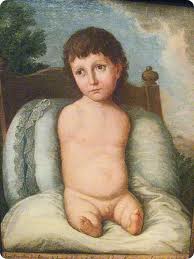 I was dismayed to realize that we missed posting on 18th century Puerto Rican painter José Campeche (1752-1809) on his birthday (January 6), but I was reminded of this event when my co-blogger recently visited the major exhibition “Campeche: Mito y realidad” [Campeche: Myth and Reality], curated by Arturo Dávila and on view at the Puerto Rico Museum of Art (MAPR), from November 2010 to February 2012.
I was dismayed to realize that we missed posting on 18th century Puerto Rican painter José Campeche (1752-1809) on his birthday (January 6), but I was reminded of this event when my co-blogger recently visited the major exhibition “Campeche: Mito y realidad” [Campeche: Myth and Reality], curated by Arturo Dávila and on view at the Puerto Rico Museum of Art (MAPR), from November 2010 to February 2012.
José Campeche y Jordán was born on January 6, 1752, in San Juan. Son of a freed slave born in Puerto Rico and a Canary Islander—Tomás de Rivafrecha y Campeche and María Jordán y Marqués—Campeche became one of Puerto Rico’s most eminent painters. Trained by Luis Paret, a court painter banished from Spain, Campeche produced approximately 400 paintings, thereby earning a reputation as “the most gifted of Latin American Rococo artist.” Devoutly religious, he often painted for churches but was also a noted portrait painter of subjects ranging from leading politicians to the local landed gentry. Some of his most famous paintings are: the portraits of Ramón de Castro and Miguel A. de Ustáriz, The Virgin of Belen, The Virgin of the Rosary, Saint John the Baptist, The Sacred Family, The Bishop of San Francisco de la Cuerda, and The Vision of Saint Anthony. The images shown here are Campeche’s El Niño Juan Pantaleón Avilés de Luna Alvarado (c. 1808) and Retrato del Gobernador Don Miguel A. de Ustáriz (c. 1789-1790).
 Arturo Dávila writes: “The 20th century opened a new phase of investigative rigor on José Campeche thanks to the institutional gathering of dispersed manuscripts and access to documentary sources—municipal, ecclesiastical, and private files in Puerto Rico, along with the inexhaustible reserve of Spanish files—and new techniques of laboratory analysis. On the one hand, these sources have confirmed information stemming from oral transmission and on the other, they have allowed for documentary findings that have been accelerating the process demystification of the figure of Campeche, expanding the collection of valuable information not only about the artist and his work but also about his family.
Arturo Dávila writes: “The 20th century opened a new phase of investigative rigor on José Campeche thanks to the institutional gathering of dispersed manuscripts and access to documentary sources—municipal, ecclesiastical, and private files in Puerto Rico, along with the inexhaustible reserve of Spanish files—and new techniques of laboratory analysis. On the one hand, these sources have confirmed information stemming from oral transmission and on the other, they have allowed for documentary findings that have been accelerating the process demystification of the figure of Campeche, expanding the collection of valuable information not only about the artist and his work but also about his family.
[. . .] In this context, this exhibition has been guided—both in the writings and the symbolic structure of the viewing spaces—by the purpose of enhancing and updating knowledge of the personality and work of this “sanjuanero” artist. Visitors will follow the steps of the Puerto Rican painter as he incorporated his country to universal art processes.”
For original description (in Spanish), see http://www.mapr.org/Exhibiciones.aspx?view=3&NodeID=12193
